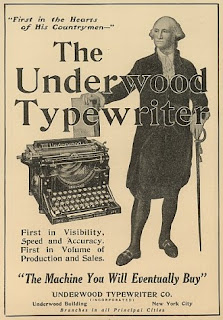JUNE 12
The Underwood-Hanson
Typewriter-Computer:
26 years, 11 designers -
Was it ever made?
For more than a quarter of a century, from 1900, Hans Hanson and a string of 10 subsequent inventor-designers working on Hanson’s original idea, planned to build a combined typewriter-computer. By computer, of course, these men meant what we would call today a calculator.Hanson was living in Minneapolis when he first applied for a patent, for what he then called a calculating machine. He moved to Brooklyn and by 1902 had expanded his vision to incorporate a typewriter.
Hanson went on applying for patents, right up to 1918. By 1905 he was in Hartford, Connecticut, and by 1912 he was assigning improvements to his designs to the Underwood Computing Machine Company, an offshoot of typewriter manufacturers John Underwood and Company.
And by then others had joined Hanson in his efforts to perfect this machine, which was being called the Underwood-Hanson typewriter-computer. In 1916, Hanson and Frederick Arthur Hart were awarded the Franklin Institute’s John Scott Legacy Medal in Philadelphia for their “Invention Embodied in John Underwood and Co's Combined Typewriting and Calculating Machine”.
Underwood itself won the Edward Longstreth Medal for its part in the development of the machine.
Hart had teamed up with Hanson in 1908.
(The Franklin Institute, named in honour of Benjamin Franklin, is a museum in Philadelphia and one of the oldest centres of science education and development in the US, dating to 1824. The Institute also houses the Benjamin Franklin National Memorial.
The John Scott Award, created in 1816, is presented to "the most deserving" people whose inventions improved the "comfort, welfare, and happiness of human kind" in a significant way. Other winners include Madame Curie, Thomas Edison and the Wright brothers.)
This report is from Science magazine on March 24, 1916:
In turn, Hart was to be followed in a succession of advances by Osmond Warren Olmsted (1912), Edward Thomas (1914), then a British designer, William L. Gumprecht (1916), and by Louis E. Giles, John Walheim, Louis L. Ansart and Frank W. Blake. Also involved were Harrison O. Blaisdell (1926) and the uber-ubiquitous Burnham Coos Stickney. By the time Blaisdell came on board the project, designs were being assigned to Elliott-Fisher, which merged with Underwood in 1927.
So, at least 27 years of effort and at least 11 different designers. Whatever became of the combined typewriter-computer? Was it ever made? And what became of the Underwood Computing Machine Company? Seems an awful lot of bother to go to for no end result.
One of the many steps along the way was this one, for which Edward Thomas, of New York, filed a patent application on this day in 1914. Thomas described the machine as one in which “the numeral keys of the typewriter set up numbers or digits temporarily in computation members, and the numbers thus set up are later carried into a gang of computing wheels”.
“In such machines it is of great advantage to have the typewriting mechanism operate with as little interference from the computing mechanism as possible. This in effect gives the machine a wider range of work, by rendering the operation of the machine for many purposes less tiring to the typist, and therefore indirectly reduces the probability of error in doing work.”
American writer Djuna Barnes (above) was born on this day in 1892, in a log cabin on Storm King Mountain, near Cornwall-on-Hudson, New York. Barnes played an important part in the development of 20th century English language modernist writing and was one of the key figures in post-World War I Bohemian Paris and Greenwich Village.
Barnes wrote eight hours a day despite arthritis so severe she had difficulty even sitting at her typewriter. Her plays showed the strong influence of the Irish playwright John Millington Synge; she was drawn to both the poetic quality of Synge's language and the pessimism of his vision.
In "The Songs of Synge", a review published in the New York Morning Telegraph in February 1917, Barnes said of Synge (above), “His method of work was much like the more modern generation who have come to their composing almost entirely on the typewriter. He also used the machine, from 10 in the morning to 12 …”
Synge, one of the co-founders of Dublin’s Abbey Theatre, is best known for his play The Playboy of the Western World, first performed at the Abbey on January 26, 1907. The play was written on a Blickensderfer 5, which is now on display in the grand library at Trinity College, Dublin (above), along with the play's original typewritten manuscript.
Barnes died in New York on June 18, 1982, six days after her 90th birthday.















1 comment:
another interesting story, and another project for the Fallow Fields Manufacturing Co. Anyone care to invest?
Post a Comment